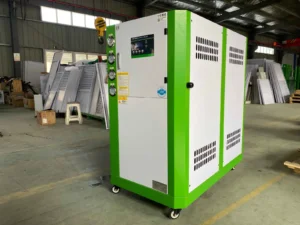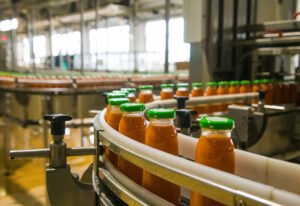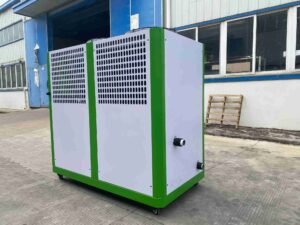An industrial chiller keeps things cool in factories and plants. This cooling system helps machines work well and stops products from getting too hot. When workers use new chillers, they have less machine stoppage and better products. Studies show that using data to check and test fluids helps machines last longer and work better. The table below shows some ways chillers help machines and products.
Ⅰ. Industrial Chiller Basics
1. What Is an Industrial Chiller
An industrial water chiller is a big machine that cools things in factories. It helps keep equipment, products, or air from getting too hot. This machine moves heat from one place to another. Pipes and heat exchangers help the chiller do its job. There are different ways to remove heat, like vapor-compression or absorption cycles.
The main job of an industrial water chiller is to keep things cool. This helps machines and products work well. Cooling helps factories stay safe and run without problems.
People pick different chillers for different needs. Some chillers use water to cool, and some use air. Each type has good points. Water-cooled chillers are quiet and use less energy. Air-cooled chillers are cheaper to set up and easy to move.
When a factory uses the right chiller, it can work longer without stopping. Machines last longer, and products are better. That is why industrial chillers are so important in factories today.
Ⅱ. How Industrial Chillers Work
1. Vapor Compression and Absorption Principles
Industrial water chillers cool things in two main ways. One way is vapor compression. The other way is vapor absorption. Both ways take away heat, but they do it differently.
Vapor compression uses a machine called a compressor. This compressor uses electricity to move the refrigerant. Most factories use vapor compression. It is easy to use and works well. Vapor absorption does not use a compressor. It uses heat, like steam or hot water, to move the refrigerant. Some factories use vapor absorption if they have extra heat or want to use less electricity.
2. Key Components Overview
All industrial water chillers have a few main parts. Each part does something important.
- The evaporator takes heat from the process. It makes the refrigerant boil and cools the liquid or air.
- The compressor squeezes the refrigerant gas. This makes the gas hotter and moves it to the next part.
- The condenser gets rid of the heat. It turns the refrigerant back into a liquid.
Here is a table to explain these parts:
| Component | Function |
|---|---|
| Evaporator | Absorbs heat from the process medium, causing the refrigerant to boil and cool the medium. |
| Compressor | Increases the pressure of the refrigerant gas, facilitating heat release in the condenser. |
| Condenser | Removes heat from the refrigerant, allowing it to condense into a high-pressure liquid. |
When these parts work together, the chiller keeps things cool. This helps factories work well and stay safe.
Ⅲ. Types of Industrial Chillers
1. Water-Cooled Chillers

Water-cooled chillers use water to take away heat. They are good for places that need lots of cooling. Big factories and plants use them often. These chillers use cool water to help remove heat. This makes them work better than other chillers. People pick water-cooled chillers for big jobs. They save energy and last a long time.
2. Air-Cooled Chillers
Air-cooled chillers use air to cool the system. They are easy to set up and move. People use them in small factories and buildings. They are good for places where saving water is important. These chillers do not need a cooling tower or extra water. They are great for areas with little water.
Air-cooled chillers use outside air to remove heat. When the air is hot, the chiller works harder. This means it uses more energy. People choose air-cooled chillers when they want something easy. They are good when you do not need much cooling.
Ⅳ. Compressor Types in Chillers
1. Reciprocating Compressors
Reciprocating compressors compress refrigerant through the reciprocating motion of a piston. They feature a simple structure and a lower cost. However, their efficiency is relatively low, and they generate significant vibration, making them suitable for chillers with small to medium cooling capacities.
2. Screw Compressors
Screw compressors utilize two intermeshing screw rotors to compress refrigerant. They offer high efficiency, smooth operation, and low noise levels, making them suitable for industrial chillers with large cooling capacities.
3. Scroll Compressors
Scroll compressors compress refrigerant through the relative motion of two scroll discs. Characterized by high efficiency, compact size, and low noise, they are commonly used in small chillers and applications requiring high-precision cooling.
4. Centrifugal Compressors
Centrifugal compressors employ high-speed rotating impellers to centrifugal compress refrigerant. They are suitable for industrial chillers requiring large cooling capacities and high efficiency, performing exceptionally well in large industrial facilities.
Ⅴ. Industrial Chiller Applications
1. Plastics and Rubber
Factories that make plastics and rubber need chillers. Chillers keep machines and molds cool. This helps products come out strong and smooth. Chillers also help workers stay safe. They stop sudden changes in heat.
2. Metalworking
Metalworking shops use chillers to cool machines and tools. Cool machines last longer and work better. For example, one printing company used a cooling unit. Their controllers lasted over two years longer. Another factory had many shutdowns from heat. After better cooling, they had no shutdowns the next year. Chillers help work keep going and save money on repairs.
3. Electronics Manufacturing
Electronics factories use chillers to keep things cool. If things get too hot, products can break. Chillers keep the temperature steady. This is important for making good electronics.
4. Food and Beverage

Food and drink factories use chillers to keep products safe. They must control the temperature very closely. Chillers give exact cooling. This keeps food fresh and safe to eat. Good chillers also stop shutdowns. Factories can keep working without worry.
5. Other Industries
Many other places use chillers too. Hospitals, data centers, and chemical plants need steady cooling. Chillers keep machines safe and products high-quality. They also help workers feel comfortable. No matter the industry, a good chiller helps a lot.
Ⅵ. Selecting an Industrial Chiller
Picking the right industrial water chiller can seem hard at first. But if you break it into steps, it gets easier. Every factory or plant has different needs. The best chiller is the one that fits those needs and helps things work well.
1. Assessing Cooling Needs
Start by thinking about what needs to be cooled. Some factories have machines that make a lot of heat. Others need to keep products at the same temperature all the time. The right chiller depends on how much heat is generated and how steady the temperature must be.
A plant manager should check the heat load first. This shows how much cooling is needed. Next, look at the work area. Hot or wet places may need a different chiller than cool, dry ones. Reliable chillers help stop breakdowns and keep work going. Some factories get bigger, so picking a chiller that can handle more work later is smart.
2. Energy Efficiency Considerations
How much energy a chiller uses is important for every business. A chiller that saves energy can lower bills and help the Earth. When people compare chillers, they look at a few main numbers:
- Seasonal Energy Efficiency Ratio (SEER): This number shows how well a chiller cools over a season. A higher number means it works better.
- Energy Efficiency Ratio (EER): This number tells how well a chiller works at one time. A higher EER means it uses less energy for the same cooling.
- Coefficient of Performance (COP): This number shows how much cooling a chiller gives for each unit of energy it uses. A higher COP is better.
Factories can save a lot of money by picking a chiller with good numbers. Energy-efficient chillers also help with green goals.
3. Refrigerant Choices
The kind of refrigerant inside a chiller is important for safety and the earth. Some refrigerants work better in certain places. Others are safer for the planet. Many new chillers use eco-friendly refrigerants that do not hurt the ozone layer.
4. Site and Environmental Factors
Where a chiller will be used changes which kind is best. Some chillers need water to cool down. Others use air. The work area can make a big difference.
A manager should look at the weather, the space for the chiller, and what kind of cooling fluid the machines need. This helps stop problems and keeps everything working.
5. Manufacturer and Cost Comparison
Cost is always something to think about. The best chiller is not always the cheapest at first. It is smart to look at all the costs, not just the first price.
A good industrial water chiller may cost more at first but save money later. Energy-efficient chillers use less power. Reliable chillers need fewer repairs. Comparing brands and models helps find the best fit for the job and the budget.
Picking the right industrial chiller means looking at cooling needs, energy use, refrigerant type, the work site, and all costs. This careful choice helps factories work better, save money, and stay safe.
Ⅶ. Future Trends in Industrial Water Chillers
With continuous technological advancements and growing global emphasis on environmental protection, the industrial chiller industry is evolving toward greater efficiency, intelligence, and eco-friendliness. Future industrial chillers will achieve significant progress in energy-saving technologies, intelligent control systems, and the adoption of environmentally friendly refrigerants. These developments will not only enhance equipment performance and reliability but also deliver greater economic and environmental benefits to users.
1. Energy-Saving Technologies
Future industrial water chillers will prioritize energy-saving technologies. Variable frequency drive technology will become standard equipment. Through intelligent control systems, chillers can automatically adjust compressor speed based on actual load, enabling precise cooling output and avoiding unnecessary energy waste. Additionally, heat recovery systems will see broader adoption. Waste heat generated during refrigeration can be recovered for heating water or other process needs, further improving energy efficiency. For instance, in food processing and pharmaceutical industries, recovered heat can preheat process water, reducing energy consumption while lowering carbon emissions.
2. Intelligent Control
With the rapid advancement of Internet of Things (IoT) technology, industrial water chillers will feature enhanced remote monitoring and diagnostics capabilities. Users can remotely control chillers anytime, anywhere via smartphones or computers, monitoring real-time operational status including critical parameters like refrigerant pressure, coolant temperature, and compressor runtime. Smart control systems can also predict potential equipment failures through data analysis, issuing early warnings to minimize downtime and maintenance costs. For instance, by monitoring compressor operation data, the system can forecast when lubricant replacement or other maintenance tasks are required, ensuring the equipment consistently operates at peak performance.
3. Environmentally Friendly Refrigerants
The adoption of environmentally friendly refrigerants will be a key future development trend for industrial water chillers. Traditional refrigerants like R22, which deplete the ozone layer and contribute significantly to the greenhouse effect, are being phased out. New refrigerants such as R32, R1234yf, and natural refrigerants (e.g., carbon dioxide and ammonia) exhibit lower greenhouse gas potential and ozone depletion potential, aligning with global environmental standards. These refrigerants not only reduce environmental impact but also enhance the cooling efficiency of chillers. For instance, the global warming potential (GWP) of R1234yf refrigerant is extremely low—only a fraction of traditional refrigerants—while delivering higher energy efficiency under identical operating conditions. This contributes to enterprises achieving their energy conservation and emission reduction goals.
Ⅷ. Conclusion
Through this comprehensive overview, we have thoroughly explored the fundamentals, operating principles, types, applications, selection criteria, installation and maintenance, as well as future trends of industrial chillers. Industrial chillers play a crucial role in modern industrial production, effectively lowering equipment operating temperatures to enhance production efficiency and product quality while significantly reducing energy consumption and production costs. Proper selection, installation, and maintenance of industrial chillers are essential for ensuring stable equipment operation, extending equipment lifespan, and enhancing overall corporate economic efficiency.
With continuous technological advancements, future industrial water chillers will increasingly emphasize energy-saving technologies, intelligent control systems, and the use of environmentally friendly refrigerants. Enterprises should actively monitor these emerging technologies to adapt to increasingly stringent environmental regulations and market competition, thereby promoting sustainable development in industrial production.

